
Chess Basics
Objective of the game
Ranking of the pieces
Moving the pieces
Chess Notation
Castling
En passant

The primary objective of chess is to capture, or checkmate, the opponent's king. The king is checkmated - and the game immediately over - when it cannot avoid capture by one of the opponent's pieces.
If a king is in danger, but can move to avoid capture, then it is said to be in check. Whenever the king is in check it must move out of this position immediately. A king cannot ever move into check, simply because the opponent can capture it on the next move.
There are three ways that a king can respond to being in check:
- The attacking piece may be captured
- A piece may be moved in between the king and the attacking piece in order to block the attack
- The king may simply move out of check itself

King - The king is considered to be invaluable because if it is captured by an opponent, the game is over.
Queen - The queen is the most powerful and dangerous piece on the chessboard, and therefore the most valuable.
Rook - The rook is considered to be a valuable piece because it is able to move along any square along its file or row as long as the path is not blocked. Like the bishop, the rook's power during a turn is entirely dependent on its scope.
Bishop - The bishop's power is directly related to its mobility, or scope, which is the number of squares that the piece can travel across unimpeded by other pieces.
Knight - The knight is nearly as powerful as the bishop not because of its range (which is limited), but because it is the only piece that is allowed to leap over other pieces during a normal move.
Pawn - The pawn is not considered to be a real piece at all. Its powers are greatly restricted and therefore has a value of almost nothing.

View the illustration of range of motion of each chess piece
| Kings: may move one square any direction. |

|
| Queens: may move as many squares as desired in any direction. |

|
| Bishops: may move as many squares as desired diagonally. |
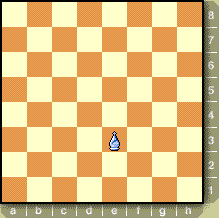
|
| Rooks: may move horizontally and vertically, as many squares as desired. |

|
| Knights: may move in an L-shape, 1 square horizontal then 2 vertical, or 1 vertical then 2 horizontal. |
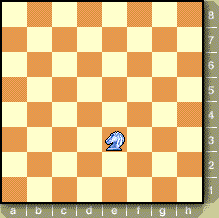
|
| Pawns: may move one square forward at a time, but it can only move forward and never move backward. |
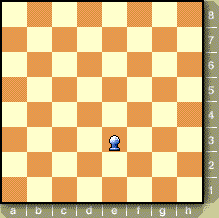
|
Pieces move along the board with no jumping. The exception is the Knight, which jumps from square to square like a horse. Pieces are blocked by other pieces (regardless of owner), and may capture an opponent's piece if they move to an occupied square. All pieces capture the same as they move, except for pawns. The pawn can move 2 squares forward on its first move. The pawn does not attack forward, it attacks diagonally. If a piece is directly in front of a pawn, the pawn is blocked. But if it sits diagonally in front, the pawn can capture it.
The king is "in check" when it could be captured by an opposing piece on the opponent's next move. A player in check must make an appropriate move to take the king out of check. Checkmate occurs when the king is in check and every available move would still result in the king being in check. Note that the player in check has the option of blocking an attacking piece or capturing it, as well as moving his king.
A player loses if he is checkmated, or if he runs out of time.

Chess boards are generally labeled by rank and file. A horizontal row of the chessboard is a "rank", numbered 1 (where the White pieces start the game) through 8 (where the Black pieces start). e.g., "White's rook on the 7th rank was paralyzing the Black king."
The vertical columns of the board are "files" and are lettered a (where the Queen's Rooks are lodged) through h (where the King's Rooks begin the game). e.g., "...the pawn exchange opened up the c file, which Black's rook was quickly able to control backed by the Queen."
Moves are described in algebraic notation, which is usually just the piece followed by the final location. The piece is described as K-King Q-Queen B-Bishop N-Knight R-Rook P-Pawn. Example Bh4 The B is Bishop which moves to square h4. If more than one of the indicated pieces can legally move to the given location, the starting square will be listed. Example Rh-b1 the Rook on the H file (not the other rook) moves to b1.
The game board
When viewing a regulation tournament chess game board, the names of the players are displayed above and below the board, with the name of the White player at the bottom and the Black player at the top.
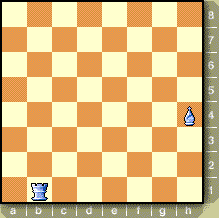
The times displayed are time remaining, which is normally 2 hours for the first 40 moves, an hour for 20 more, and a sudden death round. Compare it to football, with 3 quarters, but each team is required to make a certain number of plays or they lose!
White always moves first. The first player to get White is determined at the opening ceremony by flip of coin, with the players switching sides after each game.

Castling is a move in which the king and a rook move simultaneously. It is the only move where the king is allowed to move more than one square. It may only be carried out if:
- The king and the rook concerned have not yet moved at any time in the game.
- Provided the king and none of the squares involved are currently under direct attack by an opposing piece.
Castling kingside with the White pieces takes the king from e1 to g1 while the rook from h1 moves to f1, next to the king.
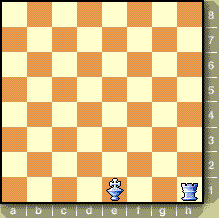
Castling queenside takes the king from e1 to c1 while the rook from a1 moves to d1. Castling with the Black pieces is self-evident from the foregoing explanation.
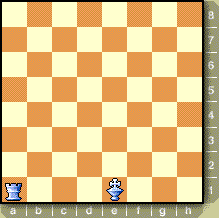
Once this move has been employed in a game the pieces involved resume their normal moving powers and castling cannot be repeated even if the pieces resume their original positions.

Note also that when castling the rook can immediately give check as a result of the move should the opposing king be on e1 or e8, as appropriate, and there are no other pieces on the e-file.

French for "in passing," en passant means that one pawn can capture another pawn if the latter attempts to pass the former on an adjacent square. It can only be effected once by each side in a game. If, for example, Black has a pawn on his fifth rank (say e4) and White, taking advantage of the facility to move a pawn two squares forward on its first move, moves (say) d2-d4, Black can capture this pawn - but only on the very next move - placing the capturing pawn on d3. An en passant capture is sometimes recorded with "e.p."

|